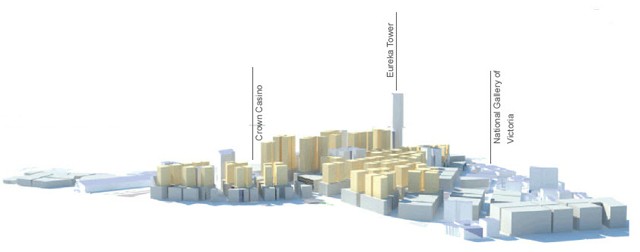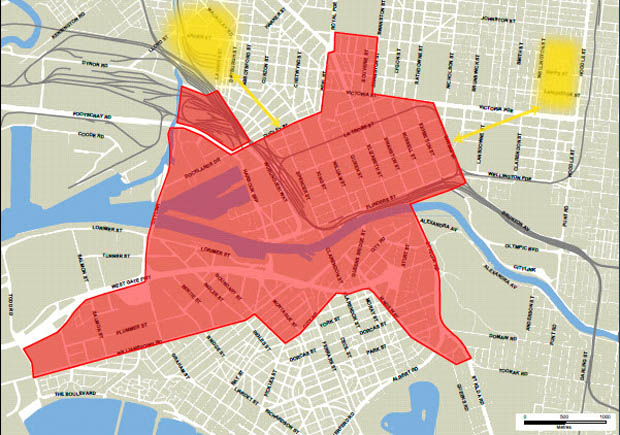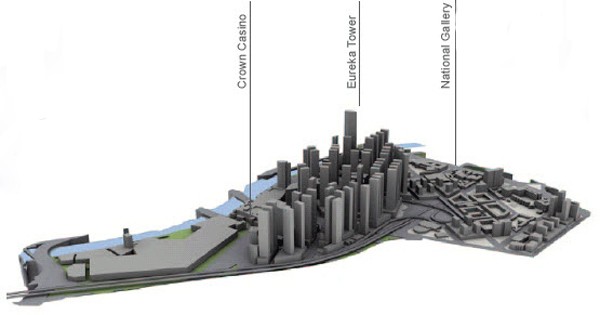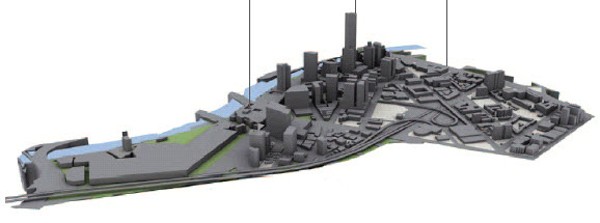
Urbanists throughout Australia and the world were startled and amazed to read of the radical 20-50 year vision for expanding Melbourne’s CBD proposed last week by Victoria’s Planning Minister, Matthew Guy.
According to the Herald Sun, which headlined its story Mega Melbourne plan for skyscrapers in suburbs, Mr Guy’s plan will “see skyscrapers stretching from Richmond to beyond the West Gate Bridge”. The Lord Mayor, Robert Doyle, described it as “bold” and “visionary”. In fact Mr Doyle went so far as to describe it as “inspirational”! Not to be out-done, Mr Guy countered with:
I think it could lead to the centre of Melbourne becoming one of the truly great high-density population areas for Western cities anywhere in the world.
Clearly, the significance of this proposal extends well beyond Melbourne. As usual though, the reality is neither as exciting nor as scary (depending on your point of view) as the hype implies, but it should nevertheless be of interest to all.
Rather than the 10 km diameter circle of wall-to-wall skyscrapers around the CBD the Herald Sun warned its readers about, the Minister’s vision is somewhat more modest. Melbourne City Council’s existing vision for Southbank might be a better guide (see first exhibit – see also where Council thinks Southbank is currently heading: third exhibit).
Mr Guy wants to expand the Capital City Zone – a planning instrument which provides more certainty for development by making a wider range of uses permissible “as of right” – to several new areas, primarily existing large redevelopment sites e.g. Fishermans Bend, eGate and the old brewery site (see second exhibit). These projects have all been announced before e.g. see here.
The Capital City Zone isn’t new. It has guided development in the CBD grid and parts of Southbank for the last twenty years (see the Minister’s media release). It should make development easier and the Minister has signalled clearly he envisages development at high densities. Indeed, it can’t have been an accident he made his announcement on Level 56 of the Rialto.
But it doesn’t provide open slather for skyscrapers – proposals are still subject to controls over matters such as height. For example, heights in the CBD shopping precinct, which is subject to the Capital City Zone, remain quite low.
I think Mr Guy’s proposal is an excellent move. More and more people want to live in the city centre and densities have to increase significantly to accommodate them. Failure to respond to this pressure increases prices in the centre and in some other parts of the metropolitan area. Moreover, research suggests people living at high density have a lower carbon footprint and lower energy use than those living at lower densities (after adjusting for differences in income and household size).

While I think the Minister should be applauded, there are a number of important issues that need to be up-front in any consideration of significantly higher densities in the city centre.
First, regard must be had for the infrastructure implications. For example, redevelopment of an area like Fishermans Bend has major transport consequences – how will it be serviced, what will it cost, and how will it be financed? It also seems odd the second exhibit doesn’t show any linkage with the proposed new Melbourne Metro rail stations at Arden and Parkville – was it prepared without consultation with the Department of Transport?
Second, there’s no explicit discussion of employment, although it’s mentioned in the press coverage. Again, the connection with transport is vital, because we know that use of cars for commuting increases steeply only a few hundred metres from the existing loop stations. The implications of greatly increasing the CBD’s job numbers also has to be thought about in terms of policy for suburban activity centres (see here).
Third, as I’ve pointed out before, central city developments are not a substitute for the need to increase housing supply in established suburbs. They certainly help, but their contribution to supply simply isn’t big enough and, moreover, they appeal to a relatively narrow demographic. Of course increasing supply in established suburbs is politically much harder but, as I’ve also mentioned before (here, here, here and here), there are potential solutions worth investigating.
Fourth, great care will be needed to ensure unreasonably restrictive height and heritage controls don’t undermine the objective of significantly increasing density. In fact skyscrapers are more likely to be the response when the supply of suitable sites is highly constrained, as is often the case in Australia’s major cities. Very tall buildings aren’t necessarily a bad thing, however high densities can be achieved without extraordinary heights. As Mr Guy said:
We are not talking about five or six storeys…(but that)…doesn’t mean we will have Rialto-size buildings in every part of it, but what you will have is greater density and greater height throughout the expanded CBD.
Fifth, exemplary urban design is mandatory. There’s no logical reason why Fishermans Bend or eGate should be urban design disasters just because Docklands is, but that experience will shape the way any large-scale proposals are received. It’s a lesson that can’t be ignored.
Sixth, there needs to be an analysis of the impact of expansion on the functioning of the existing CBD as an employment centre. Moreover, I’d like to see why the existing grid can’t be developed at greater densities/heights – I’ve yet to see a sensible rationale for the many height limits across the CBD.

Not everyone else likes Mr Guy’s vision. The Opposition planning spokesman, Brian Tee, reckons it will turn Melbourne into a “characterless wind tunnel” with gridlocked traffic. Existing CBD residents are fearful new developments will block their views. Some critics contend the Minister is simply pandering to the interests of developers.
I don’t buy that, but nor do I agree with the Minister’s proposition that it’s better to have:
someone living in high-density accommodation in the CBD area (rather) than forcing thousands upon thousands of people to live on the urban fringe where they have to drive to the centre of the city.
Increasing densities in the CBD is not a direct substitute for fringe development. Few people on the fringe work in the city centre – they work in the suburbs – and those that do tend to travel by public transport. Fringe settlers are mainly families who either have no wish to live in city centre apartments or couldn’t afford one. In this case Mr Guy is stretching what’s a great idea just a bit too far.
Finally, I’m amazed to see that of the 7,716 Herald Sun readers who responded to the question “Do you want skyscrapers in your suburbs?”, 46.4% said yes. Even though Melburnians tend to think anything over three storeys is high rise, that’s still an extraordinary result. I hope Mr Guy takes note.








Crikey is committed to hosting lively discussions. Help us keep the conversation useful, interesting and welcoming. We aim to publish comments quickly in the interest of promoting robust conversation, but we’re a small team and we deploy filters to protect against legal risk. Occasionally your comment may be held up while we review, but we’re working as fast as we can to keep the conversation rolling.
The Crikey comment section is members-only content. Please subscribe to leave a comment.
The Crikey comment section is members-only content. Please login to leave a comment.